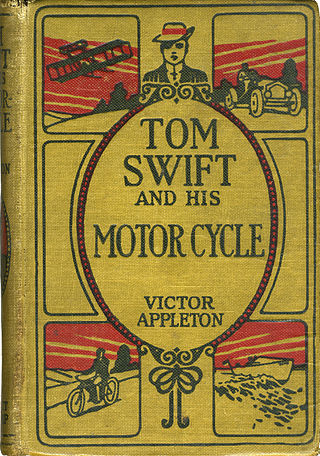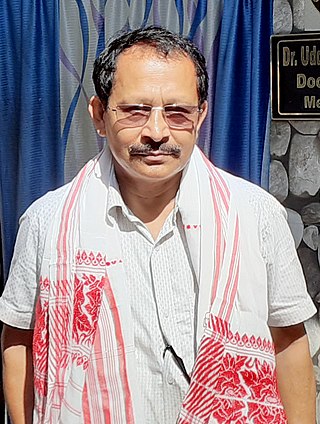
An invention is a unique or novel device, method, composition, idea or process. An invention may be an improvement upon a machine, product, or process for increasing efficiency or lowering cost. It may also be an entirely new concept. If an idea is unique enough either as a stand-alone invention or as a significant improvement over the work of others, it can be patented. A patent, if granted, gives the inventor a proprietary interest in the patent over a specific period of time, which can be licensed for financial gain.

Tom Swift is the main character of six series of American juvenile science fiction and adventure novels that emphasize science, invention, and technology. Inaugurated in 1910, the sequence of series comprises more than 100 volumes. The first Tom Swift – later, Tom Swift Sr. – was created by Edward Stratemeyer, the founder of the Stratemeyer Syndicate, a book packaging firm. Tom's adventures have been written by various ghostwriters, beginning with Howard Garis. Most of the books are credited to the collective pseudonym "Victor Appleton". The 33 volumes of the second series use the pseudonym Victor Appleton II for the author. For this series, and some later ones, the main character is "Tom Swift Jr." New titles have been published again from 2019 after a gap of about ten years, roughly the time that has passed before every resumption. Most of the series emphasized Tom's inventions. The books generally describe the effects of science and technology as wholly beneficial, and the role of the inventor in society as admirable and heroic.

The National Inventors Hall of Fame (NIHF) is an American not-for-profit organization, founded in 1973, which recognizes individual engineers and inventors who hold a U.S. patent of significant technology. Besides the Hall of Fame, it also operates a museum in Alexandria, Virginia, sponsors educational programs, and a collegiate competition.

Johann Philipp Reis was a self-taught German scientist and inventor. In 1861, he constructed the first make-and-break telephone, today called the Reis telephone.
Jerome "Jerry" Hal Lemelson was an American engineer, inventor, and patent holder. Several of his inventions and works in the fields in which he patented have made possible, either wholly or in part, innovations like automated warehouses, industrial robots, cordless telephones, fax machines, videocassette recorders, camcorders, and the magnetic tape drive used in Sony's Walkman tape players. Lemelson's 605 patents made him one of the most prolific inventors in American history.
Garrett Brown is an American inventor, best known as the creator of the Steadicam. Brown's invention allows camera operators to film while walking without the normal shaking and jostles of a handheld camera. The Steadicam was first used in the Hal Ashby film Bound for Glory (1976), receiving an Academy Award, and since used on such films as Rocky, filming Rocky's running and training sequences, and Return of the Jedi, where Brown walked through a Redwood forest with the Steadicam shooting film at 1 frame per second to achieve the illusion of high speed motion during the speeder-bike chase.

Shuji Nakamura is a Japanese-born American electronic engineer and inventor specializing in the field of semiconductor technology, professor at the Materials Department of the College of Engineering, University of California, Santa Barbara (UCSB), and is regarded as the inventor of the blue LED, a major breakthrough in lighting technology.
First to file and first to invent are legal concepts that define who has the right to the grant of a patent for an invention. Since 16 March 2013, after the USA abandoned its "first to invent/document" system, all countries operate under "first-to-file" patent priority requirement.

A snap fastener, also called snap button, press stud, press fastener, dome fastener, popper, snap and tich, is a pair of interlocking discs, made out of a metal or plastic, commonly used in place of traditional buttons to fasten clothing and for similar purposes. A circular lip under one disc fits into a groove on the top of the other, holding them fast until a certain amount of force is applied. Different types of snaps can be attached to fabric or leather by riveting with a punch and die set specific to the type of rivet snaps used, sewing, or plying with special snap pliers.
In patent law, an inventor is the person, or persons in United States patent law, who contribute to the claims of a patentable invention. In some patent law frameworks, however, such as in the European Patent Convention (EPC) and its case law, no explicit, accurate definition of who exactly is an inventor is provided. The definition may slightly vary from one European country to another. Inventorship is generally not considered to be a patentability criterion under European patent law.
American Inventor was a reality television series based on a competition to be named America's best inventor. It was conceived by Simon Cowell and the producers of American Idol, and premiered on ABC in March, 2006. It was organized as a competition between inventors nationally, resulting in one overall winner.
A patent application is a request pending at a patent office for the grant of a patent for an invention described in the patent specification and a set of one or more claims stated in a formal document, including necessary official forms and related correspondence. It is the combination of the document and its processing within the administrative and legal framework of the patent office.
Stanford University v. Roche Molecular Systems, Inc., 563 U.S. 776 (2011), was a United States Supreme Court case in which the Court held that title in a patented invention vests first in the inventor, even if the inventor is a researcher at a federally funded lab subject to the 1980 Bayh–Dole Act. The judges affirmed the common understanding of U.S. constitutional law that inventors originally own inventions they make, and contractual obligations to assign those rights to third parties are secondary.

Abraham Lincoln's patent relates to an invention to buoy and lift boats over shoals and obstructions in a river. Abraham Lincoln conceived the invention when on two occasions the boat on which he traveled got hung up on obstructions. Lincoln's device was composed of large bellows attached to the sides of a boat that were expandable due to air chambers. Filed on March 10, 1849, Lincoln's patent was issued as Patent No. 6,469 later that year, on May 22. His successful patent application led to his drafting and delivering two lectures on the subject of patents while he was president.

Uddhab Bharali is an Indian inventor from the Lakhimpur district of Assam. Bharali is credited with more than 160 innovations, starting from the late 1980s. In 2019, he was awarded the Padma Shri.

August Denayrouze (1837–1883) was an inventor of a demand valve for control of breathing air supply, and one of the inventors of a diving suit, along with Benoît Rouquayrol.

INPEX (Invention and New Product Exposition) is America's largest invention trade show, held since 1985 and organized by the invention promotion firm InventHelp. The annual show is held each June in Pittsburgh, Pennsylvania.









